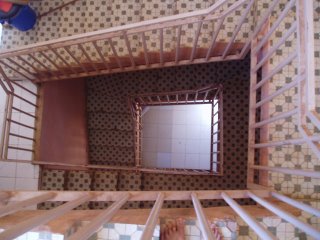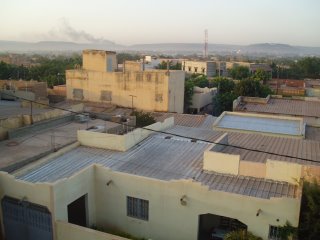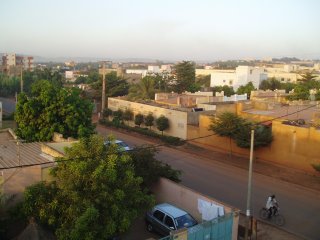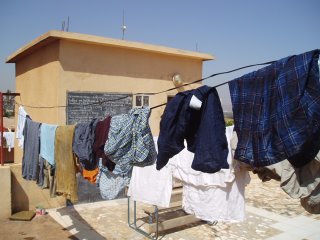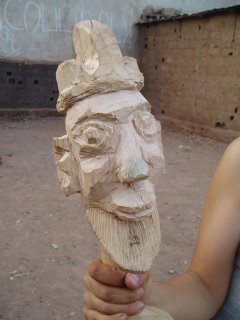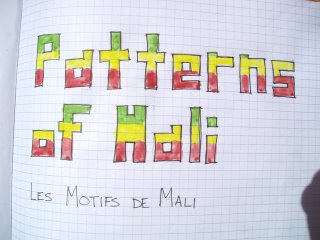Patterning Market Memories
I know that is has been awhile since I last posted, but it's been slightly crazy with our last papers and projects. Believe it or not, we leave a week from today. Enjoy this article that I wrote for class. It's a bit long, so grab your drink of choice. This should be an interesting glimpse into how I've processed this experience...
I am waiting.
Let me rephrase that; I am trying to be still. Waiting inherently implies future events, the possibility of being late for example. Stillness just asks for satisfaction with the present moment. Easier said than done for this American student. I start by observing my surroundings.
A dusty blue sky arches over Mali. In this dry season, the sun refuses to allow clouds to paint this canvas and it’s hot, but tolerable. A sheep bleats, a tailor clangs his scissors to announce his services, and a child sings “toubabou” from the doorway of a nearby house. At one point in the beginning of my semester, I would have described the garbage-strewn dirt road as filthy; it probably still is, but now my eyes just look for bits of discarded fabric that I could use for an art project. It is mid-morning and I am casting my mind out over the market I’m about to visit and don’t know what thoughts I’ll catch.
I’ve taken the bachee, the Bamako version of mass transit, enough times to seem countless. If I reflect back on these visits to the market, they blend into one memory so that each appears the same. I know they are not as any page in my journal will reveal various episodes: my first solo trip, the dismay of taking the wrong bachee, the sensory overload of the inner market. I cannot remember the specific details of each experience, just general impressions. Perhaps this is the reason why I’ve had to make this trip so many times, so I could truly understand what I was witnessing.
At this very moment, however, I am still “waiting” for my bachee. It arrives soon enough, a lurching block of green that swerves to avoid potholes and herds of goats. I flag it down with a hand and purse my lips to make a sound something between a “psssst” and a kiss. The apprenti bangs the side of the vehicle to command the driver to stop. As I climb inside, I look at a hand painted notice that limits occupancy to 20 passengers. I count 28 already sitting. The physical space that one’s body inhabits here in Mali seems driven by fluid dynamics, able to shrink and grow at will. It’s as if living along the banks of the Niger River for a millennium has caused their cultural gene pool to favor the physically adaptable. I scoot in and, closing my eyes, begin to descend into a space barely five inches wide. When I open them, I’ve squished myself in, albeit not comfortably, and we’re moving along.
On occasion, I’ve been able to sit in the very front with the driver knocking my knees as he shifts gears. Some of my classmates prefer this position but I personally find it terrifying. Looking through the windshield, I am suddenly privy to a game of Bamako transportation where the rules of the road are quite different and the only objective is, in my mind at least, to make it alive from point A to Point G (pun). The driver aims for a space in-between a Diarra Transport bus and a taxi and I swear we’re going to shear off the side mirrors. I hold my breath and clench my stomach until we’re through and I feel like I’ve cheated death once again. This is why I prefer to sit in the back, blissfully ignorant of the crashes we narrowly avoid.
I am usually fairly quiet on these commutes en ville, preferring to remain observant as an anonymous foreigner. I find that it is a good time to examine the variety of fabrics on the people sitting around me. In the market, everyone moves too fast for me to fully catch a specific motif, but stuck on the bachee, I’m free to analyze their patterns. Well, at least until it gets awkward and I pretend that I was staring out the window and not at them. Really, I’m not undressing you with my eyes, I’m just deconstructing the symmetry of your fabric, I swear! While I’ve become more educated about the fabric qualities and popular subjects, I remain clueless about fads and other nuances conveyed by one’s clothing. Are Malian teenage girls perusing through their closets like my sisters at home, complaining to their mothers that “this pattern is so last year”? Might I find a particular cut to be flattering while the elderly woman next to me mutters to herself about the declining morality of today’s youth? Clothing is an unspoken language but in my case, it is not culturally universal. By the time I reach the city, I’ve occupied my mind with more questions than answers, but I think that’s a good perspective to have while walking through the world.
I disembark at the Grande Marché in downtown Bamako and feel like Dorthy looking upon Munchkinland for the very first time. It’s as if all my senses were turned to Technicolor during my commute. Fresh goat meat sizzles on skewers made from bicycle spokes. Pungent fish dry in the harsh sun and are countered by the whiff of a perfumed business woman. The air is heavy and humid and the ground feels warm through my flip flops. Vendors shout out their wares, calling to me, the obvious toubabou in the crowd. Motos, bachees, and taxis all honk ceaselessly in their high-pitched voices and it would be cute if not for the fact that it means I’m about to be hit by one. Bright colors and bold patterns swirl, mix, and rush by with the Malians who wear them. Squint your eyes and let them unfocus. It’s easy to imagine being in a Jackson Pollack painting, where the entire canvas is not only bursting with color, but also fantastically expressive.
Some of the color pallets push the boundaries of Western aesthetics, like navy blue, mustard yellow, and neon green, while other fabrics call attention through their icons of computers, lipstick, or current political leaders. The women wear pagnes, a three piece suit of sorts that includes an ankle-length skirt, a top with flowing sleeves, and a wrap for one’s hair. The men may be dressed in their boubous, draped over their shoulders like ample tunics. These are traditional styles but not made with traditional textiles. It was common for market stands to sell dark indigo with its stark white patterns or the earth toned bogolan hand painted in dark brown symbols. Now, it is le wax, the fade-resistant fabric from Holland, which is the most popular.
This fabric is displayed in various arrangements, from loose, tossed, sheets to impressive towering stacks. In the latter, the fabric is rolled into folded bundles that, to this starved American author, resemble brick-like burritos. They are the stacked like Lincoln Logs, two to a layer, to heights that reach above my head. As I scan the designs, I hope that I don’t find the one I like at the bottom.
There is one spot in my normal market route that always bottlenecks with pedestrians. I maneuver it like jumping from one stone to another across a creek, careful not to slip into the gutter or catch the heel of the person ahead of me. As the flow of people pushes me from behind, my eye catches a particular fruit vendor with her oranges spread out in precarious stacks on the ground. She’s made pyramids, three at the base supporting another on top. Then, in order to maximize space, she delicately balances an extra orange at the apex. It’s a barely solid structure in a world of moving feet. I’d like to stay and see if any ever topple, but by that point, I’ve already been moved forward.
Walking on the “sidewalk”, that narrow and dangerous space between motos and merchants, I often find myself being passed by women holding massive aluminum bowls on their heads. A small bit of fabric is wrapped into a thick doughnut that, placed in-between the head and bowl, provides more surface area and presumably more comfort for the wearer. I get stuck in the crowd while they navigate through space in deft movements until all I can see are their wares bobbing along like vessels carried by a river’s current. It is only when they pass me that I notice that there is often a baby tied to the lower back, slung in a fabric pouch that is tied in front across the breasts. The infant looks at me with impossibly dark and wide eyes and its mouth forms a surprised “O” as if to question this awkward toubabou in the crowd.
I turn a corner into a tunnel of stalls, walking through what appears to be the tailors’ market. I’ve never been here before, though I’m certain that I pass this side street everyday. Raw fabric is of course sold, but also hundreds of zippers and hemming material that is hung like drying pasta. I follow a set of stairs to discover a balcony full of tailors, hunched over their whirring machines. They look up at me, surprised, but their hands don’t pause. A stack of discarded fabric seems like a free treasure to me until I find snot on the first scrap I grab.
I continue through the innards of the hidden market and do a double-take as I pass by two elderly gentlemen dressed in traditional bogolan shirts. They are sitting next to the rolls of hand woven cotton bands that resemble wheels of cheese. I recall that these lés are the most basic of West African textiles, the strips sewn together to form sheets. At one point in history, they were popular as currency and anyone with a loom could “print” his own money. It was still being used in World War II when the French Army commissioned Sudan for 2000 km of cotton lés for conscription and civil needs. Now it is has fallen to the back alleys of markets and I am excited to have found this stall.
I greet these two men with an “I ni sogoma” and an “I ka kene” and they are pleasantly surprised to hear a toubabou speak Bambara. I find that these greetings, no matter how butchered, are the easiest way to befriend a Malian. I consider it a form of respect to use the native language and not the one of their colonizer. As a savvy shopper, I’d also like to believe that I will be cheated less if I have this basic Bambara exchange. I am charged 250 CFA per meter and walk away with my own small wheel of cotton.
I’ve lived in Mali long enough to shed the label of tourist and yet, I cannot claim to be Malian. I covet their grace and agile movements through such market chaos and wonder if a lifetime of dancing has shaped their posture. I cannot move like that, but when I see a foreigner trying to maneuver through the crowd, I know that I don’t move like that either.
I look at the painfully obvious tourist across the street and after giving him a nod of recognition, I think, I looked like that three months ago? The clothing is always the same: cargo shorts, sweat-wicking travel top, giant backpack, sunglasses, and…God forbid… socks and sandals (which I never wore). But it is the body language that betrays his foreign origin. He’s always turning around to find his bearings, a tough thing to do when every building is two stories high. He checks his watch as if he’s late for something. He’s sweating profusely and swatting at black flies that land to suck his perspiration. Mostly, he’s walking too fast and randomly stopping to consult his map. This is a pointless effort because Bamako has more streets than the map shows and less street names than the map indicates. In this moment of confusion, I see him ambushed by a group of “helpful” young men and I watch, morbidly fascinated. It’s like lions taking down a helpless water buffalo. Standing on the other side of the street, I know that I’m safe, but also that I’m no lion. I’m the weathered and more experienced buffalo who has his own scars to prove it.
I am a little weary and make my way back to the bachee stop (amazingly indicated by an actual street sign). I’m the first one in the vehicle, which means I have another twenty minutes before we actually leave. I pass the time enjoying a frozen cranberry drink, held in a small plastic baggie, and suck thirstily from a corner. It’s Mali ji (water) I’m sure, but one of the rewards of three months here is a digestive system made of iron. I’m tired, warm, but pleasantly satiated after successful shopping.
The sun has begun its afternoon descent as I take the Gaurantiguibougou bachee to return home. Warm light spills inside and illuminates the faces of its passengers. We’re a fairly silent and tired group, the women especially. I imagine that this ride is their only reprieve from a full day of work. Household chores await them as soon as they arrive and they sit as if they relish this one opportunity to be still. It is not uncommon to see a baby nursing happily while the mother leans back and sleeps.
I glance down and my eye catches something about these women’s feet. Deep brown henna designs radiate across their toes and under their soles, called jobi in Bambara. The ink arches and crosses in beautiful curves and my feet feel naked next to theirs. Actually, looking down at mine, they look quite dirty in comparison though I know we’ve walked the same dusty streets. I am reminded of a random fact from my research that for some reason has resonated deeply in my understanding of patterns. Le wax is a batik process where wax is applied to fabric as a means to resist the dye. But it’s not perfect. There are always tiny cracks where color seeps through and the end result has a marbling effect where only empty space should exist. Consequently, the designs for le wax are created to specifically hide these imperfections, though not cover them entirely. One large motif is repeated across the fabric, a guinea fowl or presidential candidate perhaps, while the space between each image is webbed with smaller patterns. These oscillating lines and shapes mask where the dye has penetrated the wax. One can still see such crackling, but it appears more organized and controlled underneath the repeated pattern.
Is this the reason why we are so drawn to pattern, because of its ability to hide the chaos in our lives? On the tattooed feet and colored fabric of those sitting next to me, I can barely notice the red dust that seems to permeate my own skin and plain mono-toned clothing. I start to think about architectural tendencies for repetition, wooden lattice windows for example. Is the uncontrollable world outside our homes somehow visually manageable when viewed through these symmetrical frames? Have I found new questions to explore in future art projects? I think about my current drawing, a travel narrative expressed through changing patterns. My blank white sheet has been dirtied by pencil smudges and water marks from a squirt gun fight but are now barely noticeable under my black inked lines. And the designs themselves, being hand-drawn, are neither perfect nor precise; but it doesn’t matter. The individual cells of a pattern are not to be viewed in isolation; their strength and meaning comes from their connection to their neighbors. As a group, they become flawless.
This then is how I shall remember my Mali: memories of wanderings and lessons learned that have been inked across my mind. Individually, they are the faint and first stars of dusk. Collectively, they command the majesty of a crisp midnight sky. I worry, because how often are we still enough to observe the stars above, to reflect on our memories? I’ve certainly had more opportunities here in Mali and am thankful for that time. However, I need to remember that night does not happen here any more times than home. The night sky will always exist. I just need to be still enough to remember.














